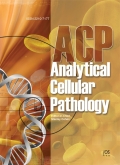Authors: Coffa, Jordy | van de Wiel, Mark A. | Diosdado, Begoña | Carvalho, Beatriz | Schouten, Jan | Meijer, Gerrit A.
Article Type:
Research Article
Abstract:
Background: Multiplex Ligation dependent Probe Amplification (MLPA) is a rapid, simple, reliable and customized method for detection of copy number changes of individual genes at a high resolution and allows for high throughput analysis. This technique is typically applied for studying specific genes in large sample series. The large amount of data, dissimilarities in PCR efficiency among the different probe amplification products, and sample-to-sample variation pose a challenge to data analysis and interpretation. We therefore set out to develop an MLPA data analysis strategy and tool that is simple to use, while still taking into account the above-mentioned sources of
…variation. Materials and methods: MLPAnalyzer was developed in Visual Basic for Applications, and can accept a large number of file formats directly from capillary sequence systems. Sizes of all MLPA probe signals are determined and filtered, quality control steps are performed, and variation in peak intensity related to size is corrected for. DNA copy number ratios of test samples are computed, displayed in a table view and a set of comprehensive figures is generated. To validate this approach, MLPA reactions were performed using a dedicated MLPA mix on 6 different colorectal cancer cell lines. The generated data were normalized using our program and results were compared to previously performed array-CGH results using both statistical methods and visual examination. Results and discussion: Visual examination of bar graphs and direct ratios for both techniques showed very similar results, while the average Pearson moment correlation over all MLPA probes was found to be 0.42. Our results thus show that automated MLPA data processing following our suggested strategy may be of significant use, especially when handling large MLPA data sets, when samples are of different quality, or interpretation of MLPA electropherograms is too complex. It remains, however, important to recognize that automated MLPA data processing may only be successful when a dedicated experimental setup is also considered.
Show more
Keywords: MLPA, copy number estimation, ratio calculation, MLPA analysis, gene amplification, aCGH, Coffalyzer
DOI: 10.3233/CLO-2008-0428
Citation: Analytical Cellular Pathology,
vol. 30, no. 4, pp. 323-335, 2008
Price: EUR 27.50





